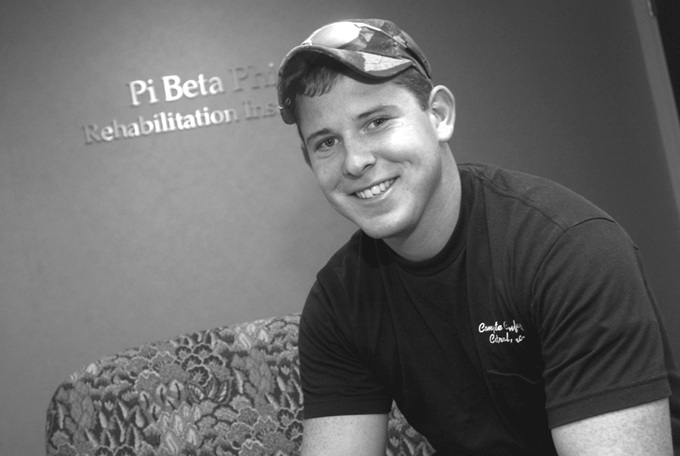|
The long way back from
the curve in the road
Teenager's return to work aided by VUMC's rehabilitation services
By Rebecca Clark

Slaughter takes a driving test with Christy Stanley, an occupational therapist at
the Pi Beta Phi Rehabilitation Institute at the Vanderbilt Bill Wilkerson Center,
as part of his ongoing recovery from a traumatic brain injury.
Jay Slaughter owned a helmet but didn’t wear it. He now wishes he had made a different decision that night last October. While driving a four-wheeler that chilly fall night, Jay Slaughter was having the typical 18-year-old Saturday night fun that teenagers have. All that fun ended when Jay went around a curve too fast and was thrown from the four-wheeler onto a dirt road. That was the last thing Jay remembered until he woke up in Atlanta’s Shepherd Center, a facility for treatment for head and spinal cord injuries, a month later.
About 1.4 million people sustain a traumatic brain injury (TBI) each year in the United States. Jay falls within two of the highest categories of those at risk
for TBI—being a male in the 15-to-19 age range.
During that month that Jay was comatose, he was cared for by the Vanderbilt trauma team for two weeks and then transferred to a skilled nursing facility for another two weeks. His family was told by physicians that he was lucky to have made it through the first night alive, but even after surviving the first few nights, there was a strong chance that he would be permanently disabled.
Filled with great determination, Jay embarked on his journey to return to the person he was before the accident—or as close as possible to that person. After being discharged from inpatient rehabilitation at Shepherd Center in Atlanta, Jay looked to Pi Beta Phi Rehabilitation Institute at the Vanderbilt Bill Wilkerson Center for his outpatient rehabilitation needs. Pi Beta Phi is an outpatient interdisciplinary rehabilitation program serving individuals with acquired brain injury. Treatment consists of speech, occupational and physical therapy in which the therapists work simultaneously to achieve related goals of the individual.
“We chose Pi Beta Phi because they were highly recommended by the staff at Shepherd,” says Jay’s father, Mike Slaughter.
Treatment is focused on three general areas—return to work, return to school and increased independence in the home and community. Jay went to therapy twice each week to work toward his goal of returning to work—in his case, both community employment and working around the farm.
“We focused Jay’s speech therapy on problem solving skills, including planning and organizing, and memory—all skills needed on the job,” says Amanda Potter, Speech-Language Pathologist at Pi Beta Phi. “His great attitude and willingness to work have been very beneficial to his progress.”
Jay lives in Lyles, Tenn., about an hour southwest of Nashville, in a tight-knit community with his family close by. He helps his uncle and grandfather on their farm, which has more than 100 head of cattle. Jay loves helping with the cows, hauling hay, coon hunting and riding horses. He eventually wants to get back to all the activities that he loves and he is hoping that his therapists at Pi Beta Phi Rehabilitation Institute will get him there. Progress is gradual but definitely present and Jay still has a lot of work to do. Thus far, he has been able to help with feeding cows and fixing fences around the farm—small steps toward his goal.
Jay was a student at Nashville Tech last fall before his accident. He had just started the HVAC program two nights each week and was working for a local company—Complete Comfort Control. In February, Jay got the approval from his therapists to return to work one day per week. At the beginning of March, he got bumped up to two days and is now working three days. Returning in more of a shadowing position, Jay helps repair commercial air conditioners—another step closer to his goal of returning to work.
“Jay’s progress has been just great,” his dad says. “He could not walk a straight line. Now, he is working three days per week and is about to begin driving lessons again. Jay has inspired everyone he has come in contact with.”

Ever since the accident, Jay has believed he would do well. He is not going to quit until he gets well and progresses to where he wants to be physically and cognitively.
“Jay has made a lot of progress in a short amount of time given his severe injury,” Potter says.
Based on his long road back from that October night, Jay has one thing he wants to say to anybody who will listen: “Whatever you do—if it says to wear a helmet—do it.”
|